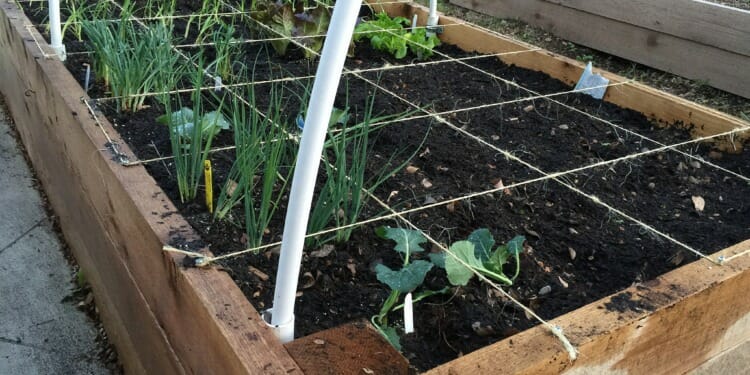Square-foot gardens are a great option for those who have small yards, or patios and want to make the most of their space. Square-foot gardening allows individuals to plant a large quantity of items in a small area.
The developer of square foot gardening was Mel Bartholomew, who was a construction engineer and used his engineering expertise to create an efficient form of gardening.
Square foot gardening requires a good deal of planning and knowledge about climate and plants, but can be well worth it. A 4 by 4 feet (1.2m x 1.2m) can be split up into 16 one foot squares, so if you have a small backyard or a large patio this could be a perfect option if you are interested in growing your own food and are keen on avoiding, as much as possible, industrial, chemical-laden products.
There are a variety of methods you can use to divide up your raised bed. A common method is to hammer nails in 12 inch (1 foot) intervals along the edges of your raised bed such that each nail has a corresponding nail opposite it. Then attach a piece of twine to each set of corresponding nails so the twine splits up the raised bed into sections. Other people lay small planks of wood across the bed to form a grid of 1 foot by 1 foot squares.
This video gives an informative overview of square foot gardening.
Advantages
Densely planted beds can form a living mulch and can prevent weeds from growing. However, gardeners do need to be diligent in the early days to make sure weeds don’t crop up and take nutrients from the intended plants.
Making covers or cages to protect plants from pests and the elements is much more practical than with larger gardens.
Intensive planting means that you can harvest a lot from a small area, which makes this ideal for gardeners with limited area.
Square foot gardening is a lot easier to set up than traditional gardening and you have more control over the soil since you aren’t dealing with whatever soil is found naturally in your yard.
Disadvantages
Square foot gardening requires a lot more planning, or unquestionably the planning is more high stakes since you have a smaller area to work with.
Building a small raised bed and filling it with the correct type of dirt can be expensive initially, especially if you compare it to planting vegetables in your garden.
The soil in raised beds can dry out faster since it is shallower than the soil in a garden. During summertime especially it can be a pain to constantly water, so some gardeners install drip irrigation systems to keep up on daily watering or when leaving home for the weekend or a short trip.
The 6-inch recommended depth may not be sufficient for deeper growing vegetables, but one can avoid this problem by building a deeper bed.
How to get started
First, it is important to do some research on what foods grow best in your climate. If you have a north-facing patio you will be more limited due to lack of sunlight, but you can always invest in some grow lights.
There are websites that will help you get started and that offer tips for planning a square foot garden
The video below explains how to set up your garden and what type of soil you can use.
Is square foot gardening a good idea for you?
There are many things to take into consideration when deciding if square foot gardening is right for you.
Do you live in a climate that is conducive to gardening? If you live somewhere with long winters and short summers, there may be a limited number of vegetables you can grow. Additionally if the growing season is short it may not give your plants enough time to fully mature. If you have an abundance of space, a raised bed lying dormant for a good part of the year might not be an issue, but if you’re using your entire patio or yard to grow vegetables a few months a year, it may be worth reconsidering.
Do you have the time to keep up with maintenance regularly? Especially at the beginning you will likely spend a lot of time setting up your garden, but there will be weeding and planting and watering that will also take up some time. If you live with other people, you could have the garden be a group project to lighten the load. This will also mean splitting the harvest, but for beginners, sharing the labor may mean the garden is more likely to be successful.
How much money are you able to spend on the project? Buying supplies and soil for the bed can be costly. Plus if you live in, say, a five floor walk up and plan on building it on your terrace, you may want to recruit a buddy to help you carry everything up.
If you have the time, energy, and money, square-foot gardens can be an efficient way to grow your own food or plants if you have limited space.
Editor’s Note: The opinions expressed here by Impakter.com columnists and contributors are their own, not those of Impakter.com. — In the Featured Photo: Square-Foot Garden Featured Photo Credit: Wikimedia Commons










